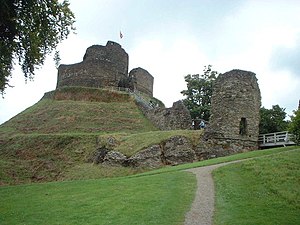| Launceston Castle | |
|---|---|
| Launceston, Cornwall | |
 | |
| Coordinates | 50°38′15″N 4°21′41″W / 50.63757°N 4.36144°W |
| Type | Castle |
| Site information | |
| Owner | Duchy of Cornwall |
| Controlled by | English Heritage |
| Condition | Ruined |
| Site history | |
| Materials | Shale |
| Events | Prayer Book Rebellion English Civil War |
| Official name | Launceston Castle motte, bailey and shell keep |
| Designated | 9 October 1981 |
| Reference no. | 1017575 |
Listed Building – Grade I | |
| Official name | Launceston Castle keep and attached buildings |
| Designated | 7 June 1993 |
| Reference no. | 1297840 |
Launceston Castle is located in the town of Launceston, Cornwall, England. It was probably built by Robert the Count of Mortain after 1068, and initially comprised an earthwork and timber castle with a large motte in one corner. Launceston Castle formed the administrative centre of the new earldom of Cornwall, with a large community packed within the walls of its bailey. It was rebuilt in stone in the 12th century and then substantially redeveloped by Richard of Cornwall after 1227, including a high tower to enable visitors to view his surrounding lands. When Richard's son, Edmund, inherited the castle, he moved the earldom's administration to Lostwithiel, triggering the castle's decline. By 1337, the castle was increasingly ruinous and used primarily as a gaol and to host judicial assizes.
The castle was captured by the rebels during the Prayer Book Rebellion of 1549, and was garrisoned by the Royalists during the English Civil War in the 17th century. Towards the end of the civil war it was stripped for its building materials and rendered largely uninhabitable. A small gaol was erected in the centre of the bailey, which was also used for executions. The castle eventually became the county gaol for Cornwall, but was heavily criticised for its poor facilities and treatment of inmates, earning it the nickname Castle Terrible.[1] By 1842, the remaining prisoners had been moved to Bodmin Gaol and the site was closed, the castle being landscaped to form a park by the Duke of Northumberland. During the Second World War, the site was used to host United States Army soldiers and, later, by the Air Ministry for offices. The ministry left the castle in 1956 and the site was reopened to visitors.
In the 21st century, Launceston is owned by the duchy of Cornwall and operated by English Heritage as a tourist attraction. Much of the castle defences remain, including the motte, keep and high tower which overlook the castle's former deer park to the south. The gatehouses and some of the curtain wall have survived, and archaeologists have uncovered the foundations of various buildings in the bailey, including the great hall.
- ^ Morris, Steven (18 August 2022). "Exhibition documents decline of Cornwall's Launceston castle". The Guardian.
